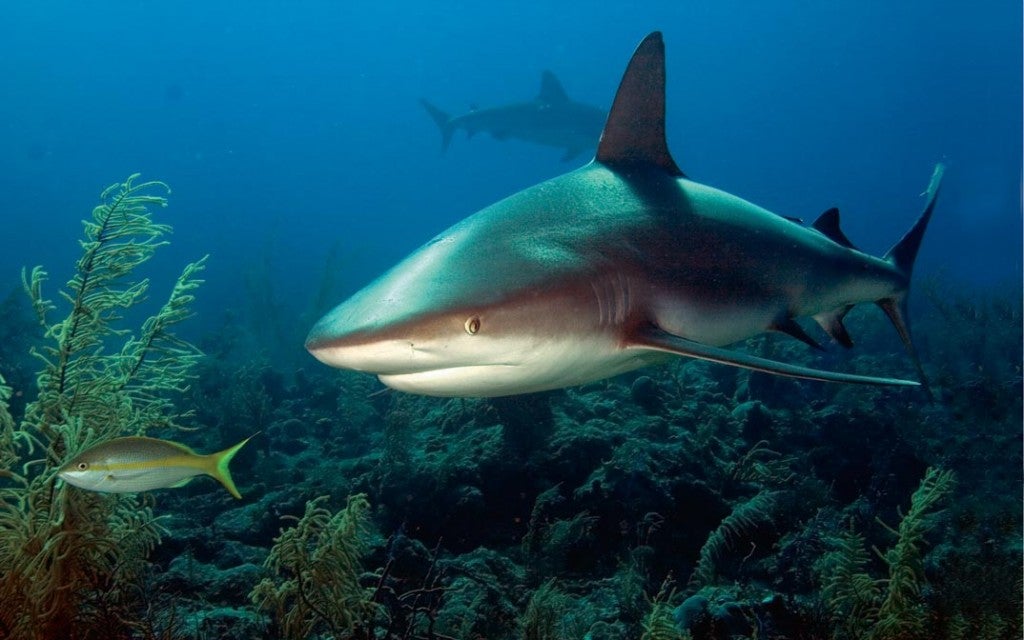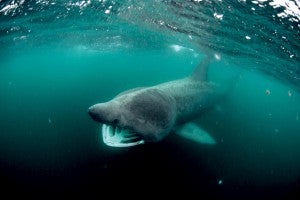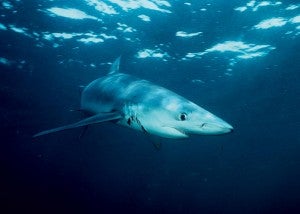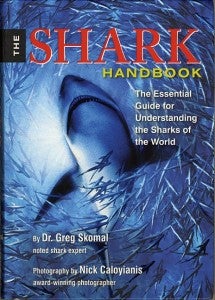Taking a Bite Out of Sharks’ Bad Reputation

As popular and groundbreaking as the 1975 movie Jaws was, its longest lasting effect was the fear it caused and the resulting senseless slaughter of sharks. Shark biologists around the world, including many with connections to the University, have been working to counteract those effects ever since. Photo by Ken Mostello
The man whose job most closely reflects the Jaws saga is George Burgess ’73. As director of the Florida Program for Shark Research and curator of the International Shark Attack File, he and his staff at the Florida Museum of Natural History collect the details of every shark attack around the world.
“It’s the equivalent of a detective investigating a case,” he said. “We interview victims and witnesses, get reports generated from emergency officials and copies of medical records, treatments and outcomes. We examine every attack from the perspective of the shark, the environmental factors, and the perspective of the humans involved.”
His database of 4,000 investigations allows him to study trends and commonalities among attacks to predict when and where shark attacks might occur and provide advice to the medical community and local officials to minimize the risk of future attacks.


Sharks come in many shapes and sizes. Above is a basking shark, the world’s second largest fish. Below is the inquisitive blue shark, one of over 400 species of sharks that Greg Skomal’s Shark Handbook will help to identify.
“Shark attacks are a function of humans and sharks getting together in the water at the same time and place,” said Burgess. “It’s obvious, but it’s the most important factor because the number of shark attacks has continued to rise every decade for a century. Despite a serious decline in shark numbers around the world, the number of attacks continues to grow because the human population continues to grow.”
In 2008, there were 59 shark attacks worldwide—41 of which occurred in the United States—that resulted in four fatalities.
“Compared to the billions of hours that humans spent in the water, that’s an infinitesimal risk,” said Burgess. “And the bottom line is that sharks have a lot more to fear from humans than humans do from sharks. Humans are killing 100 million sharks, skates, and rays worldwide each year. It doesn’t take a lot of brains to figure out who’s the hunter and who’s the hunted in this relationship.”
 A shark attack in Hawaii led Bradley Wetherbee, who teaches in the Department of Biological Sciences, to a career tracking the movements of sharks. While Wetherbee was a graduate student at the University of Hawaii tracking reef fish and studying little-known deep sea sharks, a woman was killed by a tiger shark at a nearby beach. The hysteria that followed and efforts to find and kill the rogue shark led Wetherbee to propose tracking tiger sharks to see if they remain in a small territory, as many officials believed.
A shark attack in Hawaii led Bradley Wetherbee, who teaches in the Department of Biological Sciences, to a career tracking the movements of sharks. While Wetherbee was a graduate student at the University of Hawaii tracking reef fish and studying little-known deep sea sharks, a woman was killed by a tiger shark at a nearby beach. The hysteria that followed and efforts to find and kill the rogue shark led Wetherbee to propose tracking tiger sharks to see if they remain in a small territory, as many officials believed.
“The first one we tracked moved 30 miles in one day, and the next ones moved even farther away than that,” he said. “So it’s highly unlikely that any of the sharks killed in response to the attack were the one that did it. Their efforts to control sharks were just a psychological Band-Aid.”
Wetherbee discovered that tiger sharks are not restricted to coastal regions but wander hundreds of miles up and down the Hawaiian Islands chain. His results convinced the state to stop hunting sharks.
Wetherbee has continued his shark research on the East Coast, tracking sandbar sharks and sand tiger sharks in Delaware Bay. After spending 800 hours in a tiny boat tracking sharks, he installed an automated array of listening devices in the bay that detect an acoustic signal from any of the 60 sharks he equipped with electronic tags. It has allowed him to learn about their habitat usage from one season to another and to trace their movement patterns into and out of the bay from year to year.
Apex Predators ProgramAn important step in the career evolution of Greg Skomal and Brad Wetherbee was time spent working at the National Marine Fisheries Service’s Apex Predators Program in Narragansett, next to URI’s Bay Campus. Skomal worked there as an undergraduate and graduate student, while Wetherbee held a postdoctoral appointment there. Several other alumni have served there, too. Nancy Kohler ’77, Ph.D. ’87; Lisa Natanson, Ph.D. ’90; and Camilla McCandless, Ph.D. ’07; all on staff, have collectively spent more than 50 years tagging, tracking, and studying sharks for the agency. They conduct life history studies of commercially and recreationally important shark species to shed light on their distribution and migration patterns, age and growth factors, reproductive biology, and feeding ecology. In addition, they administer the Cooperative Shark Tagging Program in the Atlantic Ocean, Gulf of Mexico, and Mediterranean Sea while also managing the Cooperative Atlantic States Pupping and Nursery Survey, which uses researchers in coastal states to conduct a comprehensive investigation of important shark nursery areas. Information gathered from these research programs provides baseline biological data for the management of large sharks in the Atlantic. |
While both species are negatively affected by fishing, port traffic, and dredging, he said, the sand tiger shark is in the greatest peril.
“It looks fierce, but it isn’t,” Wetherbee said. “It moves slowly and has little spiky teeth; it reproduces very slowly, so it will take a very long time for its population to recover.”
As a shark biologist for the Massachusetts Division of Marine Fisheries, Greg Skomal ’83, M.S. ’90, created the state’s shark research program to study and monitor sharks so they can be properly managed. He spends most of his time during the summer and fall conducting field research on some of the dozen shark species that regularly visit New England waters while also collecting data on sharks caught at regional shark fishing tournaments.
Skomal also collaborates with other researchers studying sharks around the world—bull sharks in Louisiana, black tipped and lemon sharks in the Caribbean, gray reef sharks in the central Pacific, and Greenland sharks around the Arctic Circle. This year he traveled to Hawaii to help solve a problem of tiger sharks killing endangered monk seals, worked in the Red Sea tagging whale sharks, and planned a shark conservation campaign in the Bahamas.
What’s his favorite shark? “I’m somewhat fickle,” said Skomal, whose new book, describes more than 500 species of sharks in the world. “It’s like jumping from girlfriend to girlfriend. In the last couple of years it’s been the basking shark because of the research we’re doing and because they’re so poorly understood. I’m in love with them. Four years ago it was the white shark. And my background is with the blue shark, the one I most consistently see.”
While shark researchers spend little time in the water with their subjects, Skomal covets every opportunity to dive with sharks. His most exciting underwater encounter was while studying Greenland sharks under 6 feet of Arctic ice.
“It was my first experience going through an ice hole into 29-degree water and coming face to face with a 500-pound shark,” he recalled. “It was dark and cold, and the animal was right in front of me. They eat seals, and since I’m about the size of a seal, my level of anxiety was pretty high and my imagination was racing.”
Unlike Wetherbee and Skomal, most of the shark research conducted by Biology Professor Cheryl Wilga is done in her lab. She is most interested in understanding the evolution of sharks and their adaptations for swimming and feeding.
“Why did some sharks evolve two big dorsal fins while others did not?” she asked. “Why do some feed using suction like a vacuum cleaner and others have biting jaws like a bucket loader? Why are some built like a sports car and others like a mini-van? It’s all based on their function.”–URI Biology Professor Cheryl Wilga |
Wilga raises bamboo sharks and spiny dogfish and uses a wide range of technologies to compare how they perform at various functions. Tiny electrodes shed light on muscle function; sonometric crystals use ultrasound to better understand skeletal movements; and analyses of fluid dynamics reveals the movement of water around sharks as they swim.
“We put all these things together to understand how they work,” she said. “It gives us a picture of what is happening on the inside and the outside of the shark.”
She has learned, for instance, that nurse sharks and others that use suction to feed have an advantage over other sharks because they don’t have to get as close to their prey, thereby increasing their chance of success. This vacuum feeding method also provides easy access to prey that may be hiding in rocky crevices or hidden in coral reefs.
Added George Burgess: “Sharks have been around for 400 million years, making them one of the oldest animals in the sea. They’re swimming sensory machines with more senses than we can even imagine, making them hugely effective predators. They’re a diverse group, so they’re obviously doing something right.”
-Todd McLeish
 Home
Home Browse
Browse Close
Close Events
Events Maps
Maps Email
Email Brightspace
Brightspace eCampus
eCampus


